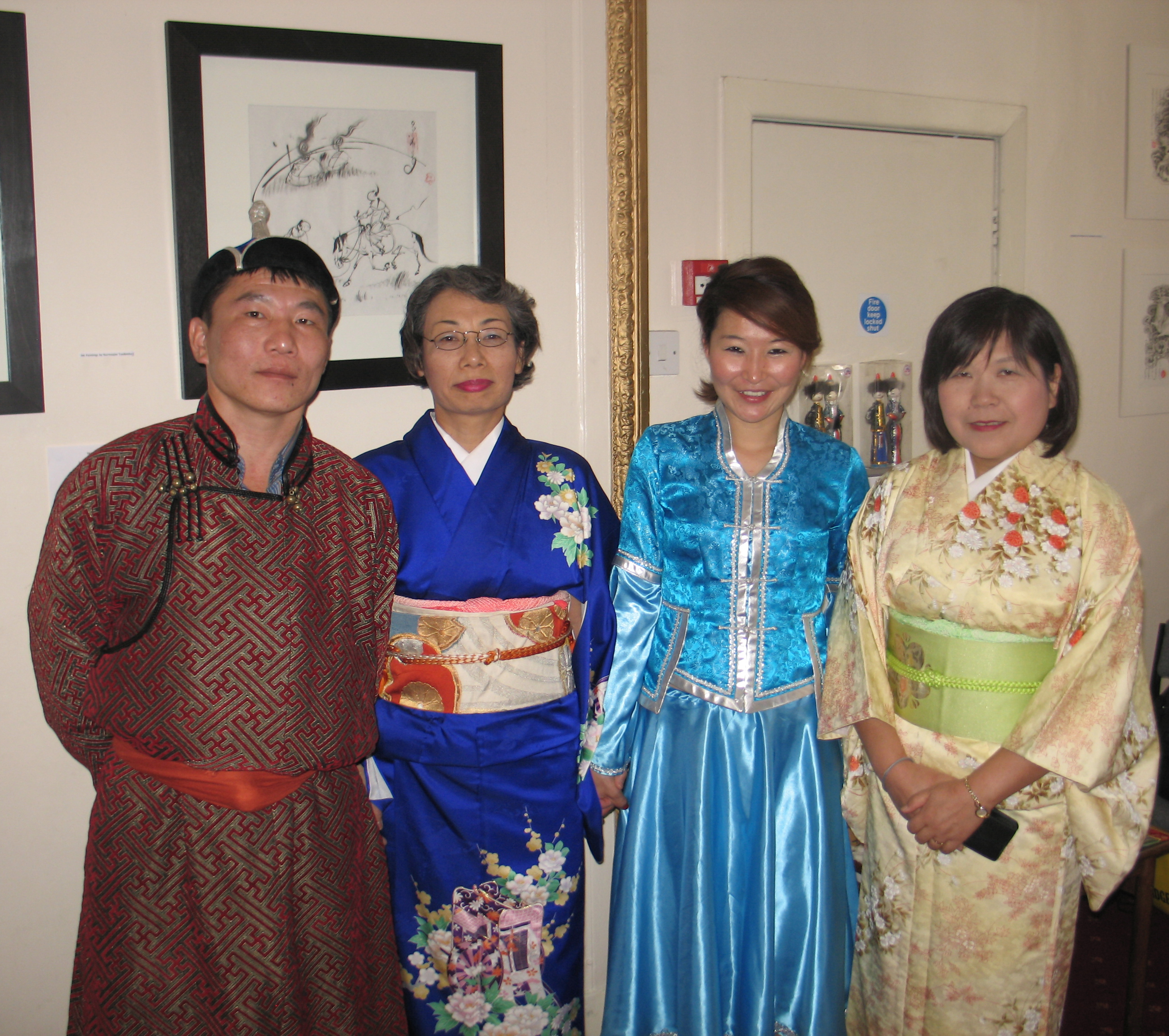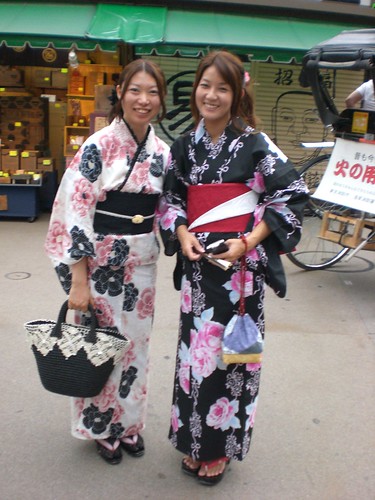source(google.com.pk)
Japanese Traditional Dress Biography
The kimono is the traditional dress of Japan, and it is worn nowadays on formal occasions. It is sometimes accused of being an impractical form of dress, but it has the advantage of giving the wearer a graceful and elegant deportment.
There are various different types of kimono for use at different times and on different occasions. Women's kimono include the furisodé and tomesodé for formal wear, the hômongi for paying calls, the tsukesagé, and the komon. Men's kimono include the montsuki hakama for ceremonial occasions and the haori for going out visiting. There is also the yukata, worn by both men and women as informal dress at home, in ryokan or for attending local festivals
.Yukata (yoo-kah-tah)
The yukata is also a part of Japanese traditional clothing, and can be considered as a casual version of the kimono. People generally wear a yukata after bathing, which is a common sight at traditional Japanese inns. These garments are meant to cool the body, are made from fabrics like cotton.
Nagajuban (naa-ga-JOO-ban)
This is a robe that takes the shape of a kimono, and is worn underneath it. Kimonos are usually made of silk, and because they are difficult to clean, a nagajuban is worn to avoid contact between the silk and ones skin. Only the edges of the nagajuban collar are visible from outside the main garment, that is, the kimono. Often, the collar of the nagajuban is covered or wrapped with a haneri for decorative and/or cleanliness purpose.
Haori (HOU-ree)
The haori is a loose-fitting, coat-like, knee-length garment. This formal-looking coat was originally worn only by men, but nowadays, it has become popular among women too. It is lightweight and generally used as a coat to keep the kimono clean.
Haori himo (HOU-ree, HEE-moh)
The haori himo is a kind of tie-up, usually a woven string, which holds the haori together. The formal color of this tie-up is white.
Hakama (ha-KAH-mah)
The hakama is a wide-pleated, ankle-length skirt. It has 7 pleats in all, 5 on the front and 2 at the back. These skirts are always worn over a kimono and can be divided (umanori) or undivided (andon bakama). Traditionally, a hakama is tied around the waist, and over the obi (sash), with ribbons. In ancient times, the hakama was worn by the Samurais so that opponents would not be able to see their footwork. Today, both sexes wear this outfit, but in the earlier days, the hakama was worn only by men.
Tabi (tah-bee)
Tabi are actually traditional Japanese socks worn by men as well as women. They are generally ankle-high, and have a separation between the big toe and the rest of the toes (divided-toe socks). The jika-tabi is often worn by workmen, since these are made of a durable material.
Zori (ZAWR-ee)
This forms a major part of Japanese traditional clothing, often worn with the kimono. Zori are open-toe sandals that are described best as slip-ons or flip-flops. They are made of leather or cloth, and can be used for both formal and informal occasions.
Obi (oh-bee, aw-bee)
The obi was worn with many types of traditional clothing, such as the kimono. This is a kind of sash that is used by both sexes. It can conceal several other sashes that are worn beneath. Obis can be tied with various knots (musubi), each having a definite meaning. In the olden days, the knots were believed to keep evil spirits away. One can also see the obi worn with martial-art uniforms. The color of the obi denotes the rank of the individual.
Obiage (oh-bee-ah-gee)
A pillow called obimakura is used to support the knot of the obi. An obiage is a piece of clothing that covers the obimakura. The obiage is significant in knowing the marital status of a woman. An unmarried woman always makes sure the obiage she wears is visible to others; as opposed to a married woman who hides it semi-discretely.
Obijime (oh-bee-JEE-may)
The obijime is a string which is tied into a knot on the obi. The string can be made from different materials such as silk, satin, or can even be woven. Generally, an obi is around 150 - 160 cm in length, with a different knot and material used for each occasion. Obidome are adornments placed over the obijime for decoration. Usually, whenever an obijime and obidome are opted for together, a thinner and flatter obijime is used. The usual ones are available in varied widths and lengths.
Kanzashi (kaan-za-shee)
Worn usually by women, this is a kind of hairpin that is used to hold a woman's hairdo in place. The appearance, nature and color of this hair ornament changes in accordance to the month or season of the year. It is usually sported by geishas and maikos, since they wear it more often.
Japanese clothing is known for its highly-detailed work, given a woman's marital status and position in the concerned society. Even a minute flaw in the arrangement or choice of clothing is considered to be an insult or a mark of disrespect.










Japanese Traditional Dress Biography
The kimono is the traditional dress of Japan, and it is worn nowadays on formal occasions. It is sometimes accused of being an impractical form of dress, but it has the advantage of giving the wearer a graceful and elegant deportment.
There are various different types of kimono for use at different times and on different occasions. Women's kimono include the furisodé and tomesodé for formal wear, the hômongi for paying calls, the tsukesagé, and the komon. Men's kimono include the montsuki hakama for ceremonial occasions and the haori for going out visiting. There is also the yukata, worn by both men and women as informal dress at home, in ryokan or for attending local festivals
.Yukata (yoo-kah-tah)
The yukata is also a part of Japanese traditional clothing, and can be considered as a casual version of the kimono. People generally wear a yukata after bathing, which is a common sight at traditional Japanese inns. These garments are meant to cool the body, are made from fabrics like cotton.
Nagajuban (naa-ga-JOO-ban)
This is a robe that takes the shape of a kimono, and is worn underneath it. Kimonos are usually made of silk, and because they are difficult to clean, a nagajuban is worn to avoid contact between the silk and ones skin. Only the edges of the nagajuban collar are visible from outside the main garment, that is, the kimono. Often, the collar of the nagajuban is covered or wrapped with a haneri for decorative and/or cleanliness purpose.
Haori (HOU-ree)
The haori is a loose-fitting, coat-like, knee-length garment. This formal-looking coat was originally worn only by men, but nowadays, it has become popular among women too. It is lightweight and generally used as a coat to keep the kimono clean.
Haori himo (HOU-ree, HEE-moh)
The haori himo is a kind of tie-up, usually a woven string, which holds the haori together. The formal color of this tie-up is white.
Hakama (ha-KAH-mah)
The hakama is a wide-pleated, ankle-length skirt. It has 7 pleats in all, 5 on the front and 2 at the back. These skirts are always worn over a kimono and can be divided (umanori) or undivided (andon bakama). Traditionally, a hakama is tied around the waist, and over the obi (sash), with ribbons. In ancient times, the hakama was worn by the Samurais so that opponents would not be able to see their footwork. Today, both sexes wear this outfit, but in the earlier days, the hakama was worn only by men.
Tabi (tah-bee)
Tabi are actually traditional Japanese socks worn by men as well as women. They are generally ankle-high, and have a separation between the big toe and the rest of the toes (divided-toe socks). The jika-tabi is often worn by workmen, since these are made of a durable material.
Zori (ZAWR-ee)
This forms a major part of Japanese traditional clothing, often worn with the kimono. Zori are open-toe sandals that are described best as slip-ons or flip-flops. They are made of leather or cloth, and can be used for both formal and informal occasions.
Obi (oh-bee, aw-bee)
The obi was worn with many types of traditional clothing, such as the kimono. This is a kind of sash that is used by both sexes. It can conceal several other sashes that are worn beneath. Obis can be tied with various knots (musubi), each having a definite meaning. In the olden days, the knots were believed to keep evil spirits away. One can also see the obi worn with martial-art uniforms. The color of the obi denotes the rank of the individual.
Obiage (oh-bee-ah-gee)
A pillow called obimakura is used to support the knot of the obi. An obiage is a piece of clothing that covers the obimakura. The obiage is significant in knowing the marital status of a woman. An unmarried woman always makes sure the obiage she wears is visible to others; as opposed to a married woman who hides it semi-discretely.
Obijime (oh-bee-JEE-may)
The obijime is a string which is tied into a knot on the obi. The string can be made from different materials such as silk, satin, or can even be woven. Generally, an obi is around 150 - 160 cm in length, with a different knot and material used for each occasion. Obidome are adornments placed over the obijime for decoration. Usually, whenever an obijime and obidome are opted for together, a thinner and flatter obijime is used. The usual ones are available in varied widths and lengths.
Kanzashi (kaan-za-shee)
Worn usually by women, this is a kind of hairpin that is used to hold a woman's hairdo in place. The appearance, nature and color of this hair ornament changes in accordance to the month or season of the year. It is usually sported by geishas and maikos, since they wear it more often.
Japanese clothing is known for its highly-detailed work, given a woman's marital status and position in the concerned society. Even a minute flaw in the arrangement or choice of clothing is considered to be an insult or a mark of disrespect.
Japanese Traditional Dress

Japanese Traditional Dress
Japanese Traditional Dress

Japanese Traditional Dress

Japanese Traditional Dress

Japanese Traditional Dress

Japanese Traditional Dress

Japanese Traditional Dress

Japanese Traditional Dress

Japanese Traditional Dress

Japanese Traditional Dress
No comments:
Post a Comment